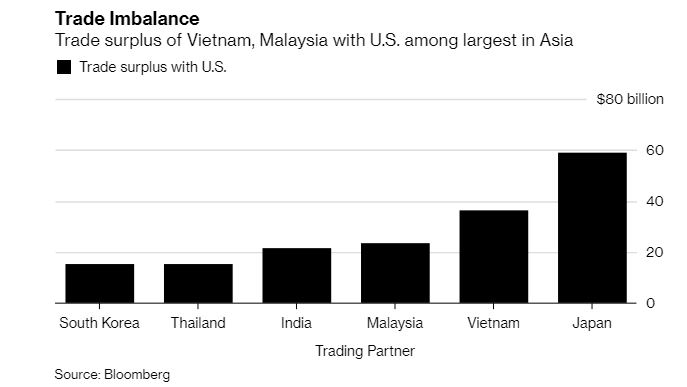Singapore made the list because of its large current account surplus and net foreign currency purchases of at least $17 billion in 2018, equivalent to 4.6% of GDP, according to the Treasury. Malaysia and Vietnam were cited for their bilateral trade and current account surpluses.
Countries with a current-account surplus with the U.S. equivalent to 2% of gross-domestic product are now eligible for the list, down from 3%. Other thresholds include persistent intervention in markets for a nation’s currency, and a trade surplus of at least $20 billion. Countries that meet two of the three criteria are placed on the watch list.
Being labeled a currency manipulator doesn’t come with immediate penalties but can rattle financial markets.

The Treasury said Singapore should undertake reforms that will lower its high saving rate and boost low domestic consumption, while striving to ensure that its real exchange rate is in line with economic fundamentals, to help narrow its large and persistent external surpluses. It also welcomed Singapore’s pledge to report more intervention data, while acknowledging that currency adjustments are its main monetary policy tool.
Singapore’s central bank said in a statement that “it does not manipulate its currency for export advantage.” The Monetary Authority of Singapore uses the exchange rate to ensure price stability and can’t use it to gain an export advantage or achieve a current account surplus, it said.
Malaysia Intervention
“Singapore’s monetary policy adjustments are primarily made through its currency, hence, intervention activities are relatively heavier,” said Christy Tan, head of markets strategy at National Australia Bank. “I doubt it will have a meaningful impact,” she said.
Malaysia was cited for its bilateral trade surplus with the U.S. of $27 billion last year and its current account surplus of 2.1% of GDP. The Treasury noted Malaysia intervened in foreign currency markets in both directions in the past, and had net sales of foreign exchange equivalent to 3.1% of GDP last year to resist the depreciation of the ringgit.
Malaysia’s central bank said the country supported free and fair trade and didn’t have unfair currency practices, adding that inclusion on the list had no consequences for the country’s economy.
“The ringgit exchange rate is market-determined and is not relied upon for exports competitiveness,” Bank Negara Malaysia said in a statement.
Trade War
The other two Asian countries on the list are Japan and South Korea. India was removed from the watch group, given that it’s met only one of the three criteria — a “significant” bilateral surplus with the U.S. — for two straight reports.
Vietnam was at risk of meeting all three of the Treasury’s new criteria for the currency manipulator tag. The Treasury excused Vietnam’s recent currency intervention, citing movements in both directions and net foreign exchange purposes that had “reasonable rationale” to rebuild reserves.
Kim Hwan, an economist at NH Investment & Securities in Seoul, said U.S.-China trade tensions may have played a role in the Treasury’s move. The fact that Singapore, Vietnam and Malaysia are added to the list “indicates the U.S. is continuing to pressure China,” said Kim. “These countries are all Southeast Asian countries that have close economic correlations with China.”
Japan was urged to enact structural reforms that would ease the public debt burden and trade imbalances, and South Korea was called on to limit currency interventions even as it was applauded for fresh disclosures on those actions.
 Tiếng Việt
Tiếng Việt 普通话
普通话




